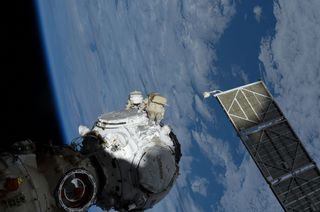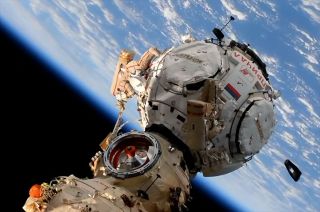Cosmonauts on spacewalk ready new Russian docking port for future space station arrivals
Russia's new multi-port docking module at the International Space Station is now ready to receive its first spacecraft after two cosmonauts completed a seven-hour spacewalk.
Anton Shkaplerov, commander of the space station's Expedition 66 crew, and Pyotr Dubrov, both of Roscosmos, exited the orbiting outpost on Wednesday (Jan. 19) to run cables to and configure the new Prichal module to be used by future Soyuz crew spacecraft and Progress cargo vehicles. The spacewalk began at 7:17 a.m. EST (1217 GMT) as the two cosmonauts opened the hatch of the Poisk mini-research module on the space-facing side of the station's Russian segment.
Once outside, Shkaplerov and Dubrov deployed the Strela telescoping boom, a 46-foot-long (14 meters) manually operated crane, which they both used to traverse Poisk and the multi-purpose laboratory module Nauka to reach their worksite beside Prichal. The new module, which adds five open docking ports, was launched to the International Space Station and attached to Nauka in November.
Video: See cosmonauts spacewalk outside Space Station's Nauka module
Related: Cosmonaut photos show space station from rare perspective

Shkaplerov and Dubrov worked fairly close to schedule as they completed the tasks to provide power, communications and route data to and from Prichal and the rest of the space station. The two cosmonauts uncovered and tied down handrails to aid future spacewalks, connected cables and installed antennas for the "Kurs" automated docking system, as well as repositioned a TV camera to provide coverage of the activities outside the new module.
"Don't trouble the trouble until the trouble troubles you," advised a flight controller in Mission Control Moscow after the spacewalkers encountered a brief snag trying to install tether guards on the new handrails.
After a brief pause, the tether guard was successfully secured.
Get the Space.com Newsletter
Breaking space news, the latest updates on rocket launches, skywatching events and more!

Shkaplerov and Dubrov also installed docking targets to be used by spacecraft approaching Prichal. Soyuz MS-21, scheduled for launch in mid-March, is expected to be first to dock with the new module, bringing with it three Russian cosmonauts to join the station's Expedition 67 crew.
At times during the spacewalk, Shkaplerov and Dubrov jettisoned thermal covers, containers and antennas that they removed from Prichal or were no longer needed. The spent hardware was pitched overboard opposite the direction that the space station was traveling to avoid their being reencountered in orbit. The covers and antennas will eventually fall back to Earth and burn up upon entering the atmosphere.
The spacewalk ended at 2:28 p.m. EST (1928 GMT) after 7 hours, 11 minutes.

Wednesday's spacewalk was the third in Shkaplerov's career and fourth for Dubrov. Shkaplerov has now logged 21 hours and 39 minutes working in the vacuum of space. Dubrov's total is now 29 hours, 49 minutes.
This was the first extravehicular activity (EVA) at the International Space Station in 2022 and the 246th for International Space Station assembly, maintenance and upgrades since construction began in 1998.
Follow us on Twitter @Spacedotcom or on Facebook.
Join our Space Forums to keep talking space on the latest missions, night sky and more! And if you have a news tip, correction or comment, let us know at: community@space.com.

Robert Pearlman is a space historian, journalist and the founder and editor of collectSPACE.com, an online publication and community devoted to space history with a particular focus on how and where space exploration intersects with pop culture. Pearlman is also a contributing writer for Space.com and co-author of "Space Stations: The Art, Science, and Reality of Working in Space” published by Smithsonian Books in 2018. He previously developed online content for the National Space Society and Apollo 11 moonwalker Buzz Aldrin, helped establish the space tourism company Space Adventures and currently serves on the History Committee of the American Astronautical Society, the advisory committee for The Mars Generation and leadership board of For All Moonkind. In 2009, he was inducted into the U.S. Space Camp Hall of Fame in Huntsville, Alabama. In 2021, he was honored by the American Astronautical Society with the Ordway Award for Sustained Excellence in Spaceflight History.

